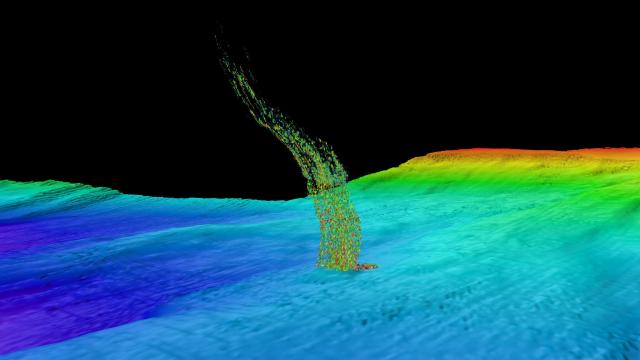Scientists have detected a disproportionate number of methane bubble plumes off the Washington and Oregon coast. The warming Pacific ocean may be triggering the release of this powerful greenhouse gas, which has remained frozen beneath the seafloor for thousands of years.
The new study, which has been accepted for publication in Geochemistry, Geophysics, Geosystems, details over 160 bubble plumes observed over the past 10 years. An inordinate number of these plumes were observed at a critical depth where frozen methane “ice”, or hydrate, decomposes on account of warmer ocean temperatures. Lead researcher H. Paul Johnson from the University of Washington says these plumes are probably not coming from the seafloor sediments, but rather from decomposing frozen methane.
The downstream effects of this leaking methane aren’t entirely clear, though historically, methane has contributed to sudden and dramatic swings in the Earth’s climate. Once in the Earth’s atmosphere, methane acts as a powerful greenhouse gas. On a related note, warming-related methane emissions have also been detected in Arctic permafrost and off the Atlantic coast.

This map shows the locations of the 168 bubble plumes included in the study. (Credit: University of Washington)
It’s also not clear how much methane gas is actually getting to the surface. The researchers say that most of the deep-sea methane is getting gobbled up by marine microbes during the journey up. These microbes convert the methane into carbon dioxide, which results in low-oxygen and acidic conditions in deeper offshore waters. From there, this tainted water trickles along the coast and makes its way into coastal waterways.
“Current environmental changes in Washington and Oregon are already impacting local biology and fisheries, and these changes would be amplified by the further release of methane,” noted Johnson in an AGU statement.
The melting methane could also destabilize the seafloor slopes.
Results of the new study show that methane gas is leaking from all depths along the Washington and Oregon coast, but the plumes are more abundant at the critical depth of 500 meters, where the decomposition of frozen methane occurs.
It’s important to point out that the researchers have yet to confirm that the plumes are actually comprised of melting methane deposits. But as study co-author Evan Solomon points out: “The results are consistent with the hypothesis that modern bottom-water warming is causing the limit of methane hydrate stability to move downslope, but it’s not proof that the hydrate is dissociating.”
The team is now performing a chemical analysis of samples emitted by sediments along the coast.
Sadly, this is yet another example of the wide-reaching effects of climate change — assuming, of course, that the researchers are correct in their assumptions. Indeed, one of the more alarming aspects of human-instigated climate change is the way it’s triggering the release of green house gases not related to human activity. These plumes, like other newly arising phenomenon (the Pacific’s warm “blob” certainly comes to mind), are a sign that thing’s aren’t right.
[ American Geophysical Union ]
